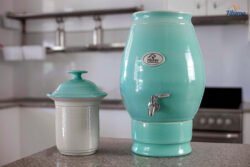
Water Treatment Plant Clarifier
Introduction
Water treatment is a critical component of modern society’s infrastructure, ensuring the safe and reliable supply of clean water to populations around the globe. One of the fundamental processes within water treatment facilities is clarification, facilitated by a piece of equipment known as a clarifier. This article delves into the intricacies of water treatment plant clarifiers, examining their design, functionality, types, technological advancements, and importance in maintaining public health.
The Basics of Water Clarification
Water clarification is a process employed to remove suspended solids from water. This is achieved by sedimentation, a process where the force of gravity helps particulate matter settle at the bottom of a tank from where it can be removed. The clarified water—free from turbidity and particulate load—can then proceed to additional stages of purification, such as filtration and disinfection.
Clarifiers are integral to both drinking water treatment facilities and wastewater treatment plants. They come in various configurations, each designed to suit different operational requirements and capacity demands. By efficiently removing suspended solids, clarifiers enhance the overall efficiency of subsequent treatment processes, reduce the load on filters, and improve the quality of the final treated water.
Types of Clarifiers
1. Conventional Clarifiers
Conventional clarifiers are the most commonly used type in water treatment plants. They consist of large, open circular or rectangular tanks designed to provide ample space for particles to settle. These systems are generally used for primary clarification and operate based on gravity separation. Influent water enters the clarifier and spreads evenly across the surface before the sludge settles at the bottom for removal.
2. Solids Contact Clarifiers
Solids contact clarifiers, also known as upflow clarifiers, integrate both the processes of coagulant mixing and sedimentation in a single tank. These systems are particularly effective for treating water with a high concentration of suspended solids. The design allows for the incorporation of chemicals that promote coagulation, forming larger particles that are easier to settle.
3. Plate and Tube Settlers
Plate and tube settlers incorporate inclined plates or tubes inside the clarifier, increasing the surface area for effective sedimentation. This design modification enhances settling efficiency, reducing the footprint of the clarifier and allowing for higher treatment capacity in a smaller space. Plate settlers are commonly used in facilities that require rapid treatment and high throughputs.
4. Lamella Clarifiers
Lamella clarifiers employ a series of inclined plates stacked closely together. Similar in concept to plate settlers, lamella clarifiers promote the rapid settling of particles due to increased surface contact. This type of clarifier is beneficial in settings where space is limited but high sedimentation capacity is essential.
Design and Functionality
Clarifiers are designed to leverage gravity separation to achieve particulate removal. The flow of water through a clarifier is controlled to ensure optimal conditions for sedimentation. Key design parameters include:
- Inlet and Outlet Configurations: Ensures uniform flow distribution to prevent short-circuiting and maximize retention time.
- Sludge Collection Systems: Mechanisms such as scrapers or suction devices that facilitate the removal of settled solids.
- Weir Design: Outflow weirs help control the effluent water level, maintaining the desired water surface in the clarifier.
Many modern clarifiers include automated control systems to monitor and adjust operational parameters, ensuring consistent performance and efficiency.
Performance Factors
Several factors influence clarifier performance, including:
- Influent Characteristics: Particle size, density, and concentration significantly affect the settling process.
- Hydraulic Load: The rate of water flow through the clarifier impacts retention time and settling efficiency.
- Temperature: Water temperature can influence fluid viscosity and settling rates.
- Chemical Additives: Coagulants and flocculants are often added to enhance particle aggregation and settling.
Optimizing these factors is key to achieving high clarification efficiency and minimizing the risk of process disruptions.
Technological Advancements
Advances in technology have significantly enhanced the performance of water treatment clarifiers. Modern clarifiers are equipped with sophisticated monitoring systems that utilize sensors and automation to ensure optimal operation. Smart interfaces provide real-time data analytics, facilitating predictive maintenance and operational adjustments to maximize efficiency.
Innovations in material science have led to the development of more resilient and durable clarifier components, reducing maintenance requirements and increasing longevity. These advancements have also enabled the construction of lighter and more compact designs—important for retrofitting existing facilities with space constraints.
Importance in Water Treatment
Clarifiers play a vital role in maintaining the public health by effectively removing pathogens and pollutants from raw water sources. By minimizing suspended solids and turbidity, clarifiers facilitate the action of downstream treatment processes such as filtration and disinfection, ensuring compliance with stringent water quality regulations.
In wastewater treatment, clarifiers are essential for reducing biological oxygen demand (BOD) and total suspended solids (TSS), thereby protecting aquatic ecosystems and preventing the spread of waterborne diseases.
Challenges and Maintenance
Despite their critical function, clarifiers face challenges such as sludge management, variation in influent conditions, and potential clogging or overflow issues. Effective maintenance strategies include:
- Regular Cleaning: Ensuring that sludge is promptly removed to prevent build-up and potential blockages.
- Inspection and Repairs: Routine inspection of mechanical parts such as scrapers and weirs to identify wear and tear.
- Monitoring Influent Quality: Adjusting operational parameters based on changes in influent load and composition.
By adhering to these preventative measures, water treatment plants can maintain the reliability and efficiency of their clarifiers.
Conclusion
Water treatment plant clarifiers are indispensable in both potable water and wastewater treatment processes. Their ability to effectively remove suspended solids and reduce turbidity is crucial for safeguarding public health and protecting the environment. As technology continues to advance, clarifiers are becoming more efficient, adaptive, and integrated into smart water management systems. Understanding the design, operation, and maintenance of clarifiers allows for ongoing improvements and innovations, ensuring they continue to meet the evolving demands of modern water treatment needs.

